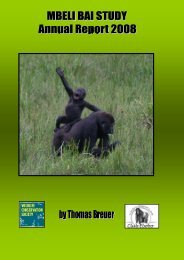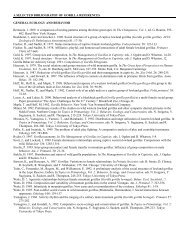First Prosimian Husbandry Workshop 2009 - Cleveland Metroparks ...
First Prosimian Husbandry Workshop 2009 - Cleveland Metroparks ...
First Prosimian Husbandry Workshop 2009 - Cleveland Metroparks ...
Create successful ePaper yourself
Turn your PDF publications into a flip-book with our unique Google optimized e-Paper software.
They are omnivorous and have a longer digestive tract, therefore gut transit time (7 to8 hours) is<br />
slower. Cecum is similar in size to the ruffed lemur cecum, this is where fiber is broken down by<br />
bacteria. Volatile fatty acids are produced by breakdown of fiber in cecum and are absorbed by the<br />
mucosal wall. Because of their longer gut, they can be fed high-fiber diets.<br />
Sifaka:<br />
This is a folivorous species with a very long gut. Fiber fermentation occurs in the cecum and gut<br />
transit time is 24-48 hours.<br />
Question: (Monica Mogilewsky) Are crowned lemurs closer to ruffed and mongoose closer to ringtailed?<br />
Answer: They are all very similar to the ring-tailed gut morphology.<br />
Comment (Karen Weisenseel): Gut transit time studies have been done in mongoose lemurs.<br />
Comment (Chris Kuhar): We have been trying to use dye to identify vomit in a ruffed lemur, short<br />
transit time may be the reason we have had issues with this.<br />
Moderator (Cathy Williams): Ruffed lemurs can utilize a lot of simple sugars, if you give the sifaka<br />
simple sugars you will switch the bacteria population in the gut. This can cause diarrhea.<br />
Necropsy of folivorous animals fed high sugar diets, have died quickly.<br />
Question: (Monica Mogilewsky) What about feeding Varecia fiber?<br />
Moderator (Cathy Williams): There can be benefits to doing this. Humans don’t have a cecum, but<br />
still need fiber for water balance, stool consistency, transit time, colon health, slows rate of sugar<br />
entering bloodstream. However, ruffed lemurs cannot get energy from the fiber.<br />
Question: (Jessica Franke) If an animal has been fed a bad diet, can they develop the good bacteria<br />
if their diet is changed?<br />
Moderator (Cathy Williams): Yes, over time it will shift.<br />
Question: (Jessica Franke) What happens during the initial switch-over?<br />
Moderator (Cathy Williams: There is time where they have to get used to new diets. Best way to<br />
do this is through gradual change which helps animals adjust better.<br />
Question (Megan Elder): Are probiotics helpful?<br />
Moderator (Cathy Williams): No data on this. Probiotics are in the lactobacilis family, they are not<br />
the same bacteria in the intestinal tract of the lemur. Probiotics are not cellulose or fiber digesting<br />
bacteria. It shouldn’t hurt or benefit lemur diets.<br />
Question: Can we process carbohydrates by cooking to create simple carbohydrates i.e. yams?<br />
This can be a cheaper alternative.<br />
Moderator (Cathy Williams): Problem with simple carbs is that they cause a spike in the glucose<br />
which over time is not good, even for ruffed lemurs. The effect is more negative. If they are<br />
getting enough nutrients, they do not need this many simple carbs.<br />
Question: Where is the preference to get the simple carbs from?<br />
Moderator (Cathy Williams): All simple sugars are absorbed easily without much processing along<br />
with starch. When you start binding the glucose into hemicellulose etc., this takes time to process<br />
and slows down the absorption of the carbs into more of a steady peak.<br />
Question: Can you tell us anything about intestinal tracts of Asian nocturnal prosimians?<br />
Moderator (Cathy Williams): Jenny Campbell has studied this. Intestinal tracts and cecums were<br />
very small and more associated with a high protein, insectivorous diet. No info on gut transit time.<br />
9




